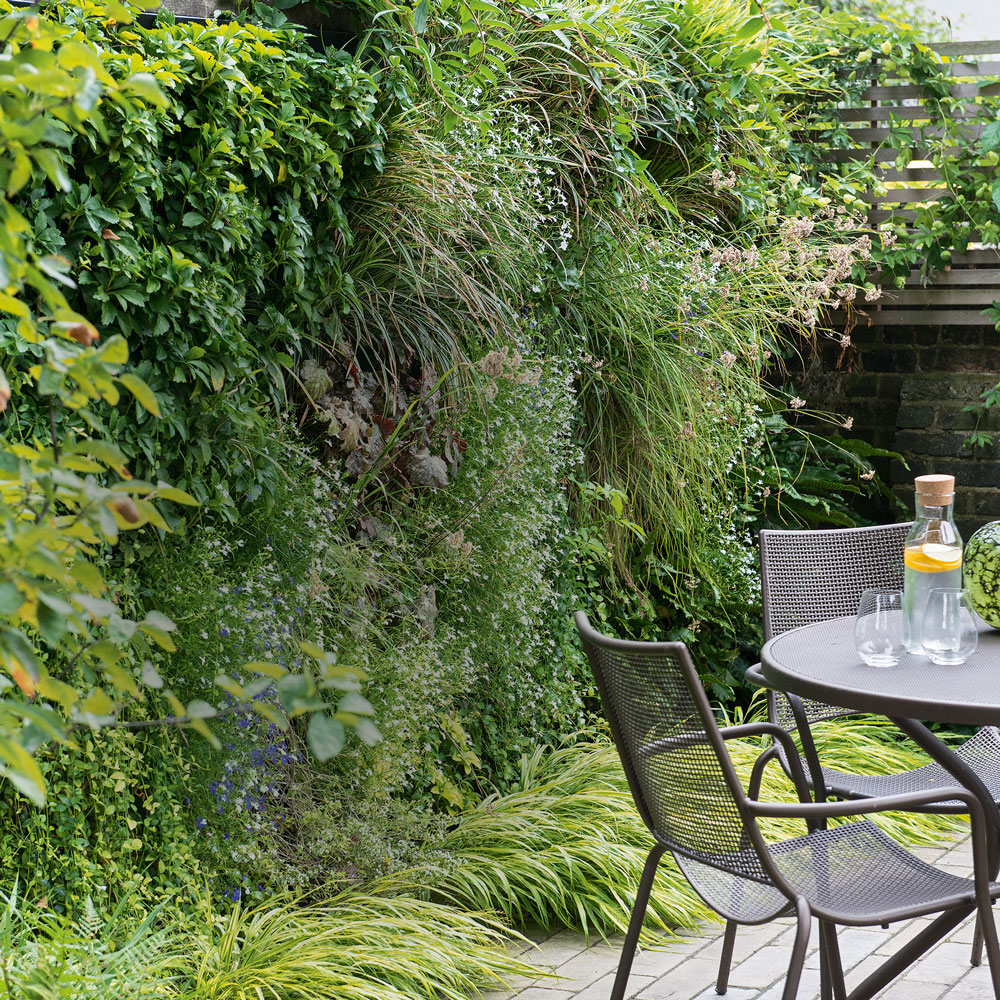
Looking for creative ideas to bring more green into your space? A living wall is a perfect solution. This vertical garden will not only add beauty to your surroundings but also provide a range of benefits. Green walls can help purify the air, reduce noise pollution, and create a sense of tranquility in urban areas.
Creating a living wall garden requires the right conditions, including access to water and the choice of suitable plants. Opt for plants with low water requirements, such as carex, thyme, vinca, and heuchera. These plants can thrive in both indoor and outdoor settings.
When it comes to planting your green wall, you have several options. You can choose a modular system that allows for easy installation and planting, or you can opt for a more traditional method using woolly pockets or plastic pots. Whatever system you choose, ensure proper irrigation so that your plants receive the right amount of water.
To care for your living wall, regular maintenance is necessary. The level of care will depend on the types of plants chosen and the system used. Generally, living walls require regular watering, pruning, and fertilization. However, some systems have built-in irrigation and require minimal maintenance.
Spring is the ideal time to start your living wall garden. This is when most plants are in their active growth phase and will establish well in a new environment. Consider the climate and conditions in your area when choosing the plants for your green wall. Some plants, such as sedge and heucheras, are more suited to colder climates, while others, like vinca and thyme, can tolerate heat and drought.
In conclusion, a living wall garden is a creative way to bring more green into your space. With the right plants and irrigation system, you can create a beautiful and sustainable garden that will add beauty to your surroundings. Take care of your living wall garden, and it will take care of you!
Living wall ideas
If you’re looking to add a touch of green to your living space, a living wall is a great solution. Living walls, also known as green walls or vertical gardens, are a creative way to bring plants indoors or transform an outdoor space into a lush garden. There are a range of ideas and plant options to choose from, so you can create a living wall that suits your style and environment.
Plants for your living wall
When it comes to choosing plants for your living wall, there are many options available. Some popular choices include heucheras, vinca, sedge, and thyme, which vary in color, texture, and growing conditions. Heuchera, also known as coral bells, has vibrant foliage that comes in a range of colors, while vinca is a trailing plant with small lavender flowers. Sedge and thyme are both groundcovers that can tolerate dry conditions.
Creative ways to arrange your plants
Once you’ve chosen your plants, you can get creative with how you arrange them on your living wall. You can group plants with similar growth habits together or mix and match different plants to create interesting patterns. Playing with colors, textures, and heights will give your living wall a dynamic and eye-catching look.
Choosing the right system for your living wall
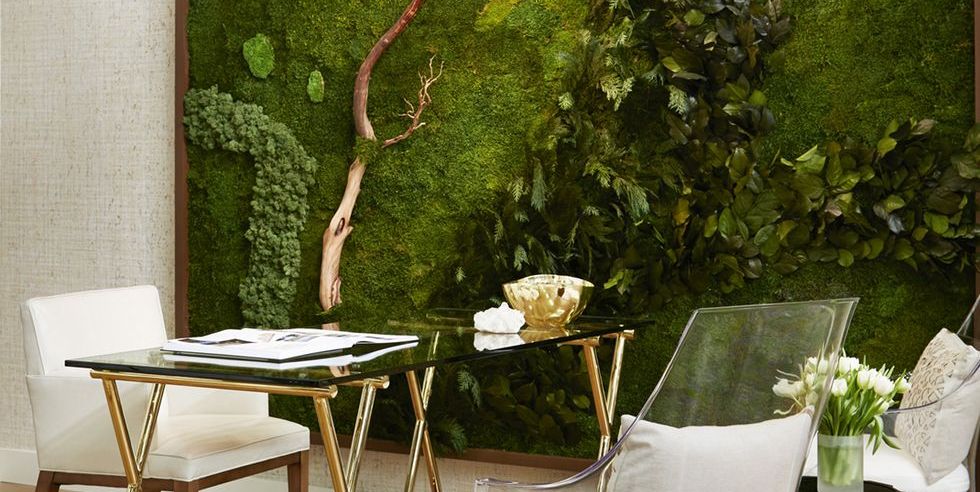
There are different systems available for creating a living wall, depending on your needs and space. One option is a soil-based system, which means your plants will be rooted in soil and require regular watering and care. Another option is a hydroponic system, which uses a water-based solution to deliver nutrients to the plants. Hydroponic systems require less water and can be easier to maintain.
Watering and irrigation
Proper watering is essential for the health of your living wall. Depending on the plants you’ve chosen and the system you’re using, you may need to water your wall manually or set up an irrigation system. Some systems have built-in irrigation, which helps distribute water evenly to all the plants. It’s important to monitor the moisture levels and adjust your watering routine accordingly.
Maintenance and care
Like any garden, living walls require some maintenance and care. Regular pruning and trimming will help keep the plants in shape and prevent them from overcrowding each other. It’s also important to monitor for pests and diseases, and take necessary steps to control them. Following a proper care routine will ensure that your living wall remains healthy and vibrant.
In conclusion, creating a living wall is a creative and green way to bring nature into your living space. With the right plant selection, arrangement, and care, your living wall can be a stunning addition to any home or outdoor area. So why not start planning your own living wall garden today?
1 Make your living wall a focal feature
- A green wall is a great solution to bring life to any space, whether it’s indoors or outdoors.
- When designing your living wall, consider making it a focal feature in your garden.
- There are different systems available that can help you create a green wall that will stand out and attract attention.
- One popular option is the Biotecture system, which allows you to create a green wall with a range of different plants.
- For a more natural look, you can choose plants such as sedge (carex) and heucheras, which have attractive foliage.
- By taking care of the plants in your living wall, you can ensure that they thrive and stay looking green and lush.
- This means providing them with the right amount of water and ensuring they are well taken care of.
- Heuchera, for example, is a popular choice for living walls as it can tolerate a range of conditions and requires minimal care.
- Spring is a great time to plant your living wall as many plants, like thyme and vinca, are at their best during this season.
- When installing your living wall, make sure you have a good irrigation system in place to ensure the plants receive enough water.
- With the right system and chosen plants, you can create a living wall that will transform your garden into a green oasis.
2 Take it indoors
Another creative way to incorporate a living wall into your space is by taking it indoors. This means you can enjoy the benefits of a green wall garden all year round, regardless of the weather conditions outside.
Indoor gardens are a great solution for those looking to bring some greenery into their homes or offices. They not only provide a visually stunning backdrop but also help to improve air quality and create a healthier environment.
When choosing plants for your indoor living wall, it’s important to consider the conditions of your space. Some plants, such as thyme, carex, and heucheras, will thrive in low-light areas, while others, like vinca and sedge, require more sunlight.
One of the key factors in a successful indoor living wall is the irrigation system. You need to ensure that your chosen plants are getting the right amount of water. Installing a drip irrigation system is a popular choice as it provides a steady supply of water to your plants without overwatering them.
In addition to the watering system, it’s essential to take care of the overall well-being of your indoor garden. Regularly monitor the moisture levels of the soil, prune any damaged foliage, and fertilize the plants as needed.
If you’re not sure where to start or how to incorporate a living wall into your indoor space, there are plenty of companies like Biotecture that specialize in indoor green wall installations. They have a range of creative ideas and will work with you to design a living wall that suits your specific requirements.
So, whether you want to create a small herb garden in your kitchen or a grand living wall installation in your office lobby, taking your green wall indoors is a fantastic way to bring nature into your everyday life.
3 Create a vertical attraction
If you have the right conditions, creating a vertical garden can be a great way to add interest and beauty to your outdoor space. There are several systems you can incorporate into your garden to achieve this, such as using modular panels that can be easily attached to walls or fences.
One idea is to plant heucheras and carex in the modular panels. Heucheras, also known as coral bells, have vibrant foliage that will add a pop of color to your garden. Carex, or sedge, is a grass-like plant that is easy to grow and requires minimal care.
Biotecture is a company that specializes in creating vertical gardens, and they have developed a system called the “living wall.” This system uses a water solution and irrigation to provide the plants with the necessary nutrients and moisture. The plants are planted into felt pockets, which help them retain water and prevent drainage issues.
If you’re looking for a low-maintenance option, spring bulbs like thyme and vinca can be a good choice. These plants are drought-tolerant and will thrive in a vertical garden. They can be planted in modular panels or in hanging baskets attached to a wall.
When choosing plants for your vertical garden, it’s important to consider the growing conditions of your chosen area. Some plants may require full sun, while others may prefer shade. Research the plants you are interested in to ensure they will thrive in your garden.
By incorporating a vertical garden into your outdoor space, you can create a unique and eye-catching attraction. Whether you choose to use modular panels or hanging baskets, the right plants and care will help ensure that your living wall garden thrives.
For more creative ideas and inspiration for green walls and gardens, check out our website and sign up for our newsletter. You’ll receive tips and tricks right to your inbox!
4 Take inspiration from nature
When creating a living wall, it’s important to take inspiration from nature and consider the natural conditions that plants thrive in. By mimicking these conditions, you can create a green wall garden that is not only visually stunning but also sustainable and easy to maintain.
One way to do this is by choosing plants that are native to your area. Native plants are well adapted to the local climate and soil conditions, which means they will require less water and care compared to non-native species. They will also attract local wildlife, such as birds and butterflies, adding life and biodiversity to your living wall.
Another way to take inspiration from nature is to create a water-wise system for your living wall. Biotecture has developed innovative irrigation systems that mimic the natural water cycle, reducing water consumption and creating a self-sustaining green wall. These systems collect and filter rainwater, which is then distributed to the plants through a grid of pipes and emitters. This ensures that each plant receives the right amount of water, minimizing waste and promoting healthy growth.
When choosing plants for your living wall, consider the wide range of foliage and textures found in nature. Combine different plants with contrasting leaf colors and shapes to create an eye-catching and dynamic display. For example, mix plants like sedge, heuchera, vinca, and thyme to create a tapestry of color and texture.
In addition to foliage, consider incorporating other elements found in nature, such as rocks, moss, and wood, into your living wall design. These natural materials not only add visual interest but also provide habitats for beneficial insects and microorganisms.
By taking inspiration from nature, you can create a living wall garden that not only looks beautiful but also supports biodiversity and enhances the natural environment. Whether you’re looking for a small vertical garden for your balcony or a large-scale green wall for a public space, incorporating nature-inspired elements and plant choices will ensure a successful and sustainable living wall garden.
5 Use the right planting system
When creating a living wall garden, it’s important to choose the right planting system to ensure the success of your green wall.
There are several different planting systems available, each with its own benefits and considerations. One factor to consider is the type of plants you will be using in your green wall. Some plants are better suited for certain planting systems than others.
One popular planting system is the modular system. This system uses individual containers that can be easily affixed to the wall and arranged in various configurations. The containers have built-in irrigation systems that deliver water directly to the plants, creating a self-sustaining green wall.
Another option is the hydroponic system, which involves growing plants in water without soil. This system is ideal for areas with limited space or for those looking for a more high-tech solution. Hydroponic systems can be integrated into existing walls or structures, creating a seamless green wall garden.
Another important consideration when choosing a planting system is the size and conditions of your green wall. Some systems are better suited for smaller walls or indoor gardens, while others are designed for larger outdoor areas.
For example, if you’re looking to create a green wall garden in a sunny outdoor location, a system that incorporates drought-tolerant plants such as thyme or vinca may be the best choice. These plants can withstand hot, dry conditions and require less water and care.
On the other hand, if you have a shaded area and want to add some color and texture to your green wall, plants like heucheras, carex, or sedge may be a better option. These plants have vibrant foliage that can brighten up any space.
No matter which planting system you choose, it’s important to consider the irrigation needs of your plants. Some systems have built-in irrigation systems that provide a consistent water supply, while others may require manual watering.
Take the time to research and choose the right planting system for your green wall garden. This will ensure that your plants thrive and your green wall remains healthy and beautiful.
6 Pick the perfect spot for a living wall
When it comes to creating a living wall, the location you choose is crucial to ensure the success of your green wall garden. Here are some important factors to consider:
- Light conditions: Take into account the amount of sunlight that the chosen area receives throughout the day. Some plants may require full sun, while others prefer shady spots.
- Water availability: Consider the proximity to water sources for irrigation. Living wall systems typically have built-in irrigation systems, but it’s important to ensure that there is easy access to water for maintenance purposes.
- Space: Determine how much space you have available for your living wall. This will help you decide on the size of the system and the number of plants you can incorporate into it.
- Climate conditions: Consider the climate conditions in your area. Different plants have different requirements and may thrive better in certain climates. Make sure to choose plants that are suitable for your local climate.
- Structural support: Ensure that the chosen area can support the weight of the living wall system, especially once it’s fully grown and filled with plants. Some walls may require additional structural support.
- Aesthetic appeal: Finally, consider the visual impact you want your living wall to have. Choose a location that can be easily seen and enjoyed, whether it’s in your garden, on a balcony, or even indoors.
Taking all these factors into account will help you make the right decision when choosing the perfect spot for your living wall. Whether you’re looking to create a small herb garden, a vibrant foliage display, or a statement piece for your outdoor space, careful planning and consideration of the location will ensure the success of your green wall garden.
7 Use the best plants for your garden wall
When it comes to creating a living wall garden, choosing the right plants is crucial. The plants you select will determine the overall look and feel of your green wall, as well as its ability to thrive in the given conditions. Here are some ideas for plants that will work well in a garden wall:
1. Vinca
Vinca is a popular choice for garden walls because of its beautiful and vibrant flowers. It requires little maintenance and can tolerate a wide range of conditions, making it an ideal plant for a living wall.
2. Heucheras
Heucheras are another excellent option for a green wall. Their colorful foliage adds a creative touch to any garden, and they can tolerate both sun and shade. With their vast range of colors, Heucheras are sure to bring life to your garden wall.
3. Carex
Carex, also known as sedge, is a versatile plant that can be grown in various conditions. Its grass-like foliage adds texture to the green wall, and it is low-maintenance, making it a perfect choice for busy gardeners.
4. Thyme
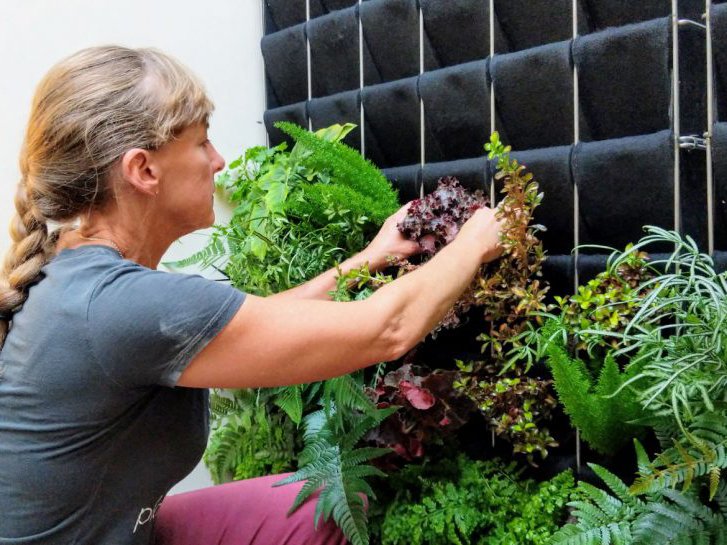
If you’re looking for a fragrant option, thyme is an excellent choice for a garden wall. Its aromatic foliage will lend a delightful scent to your space while adding a touch of greenery. Thyme requires little water and is well-suited to xeriscaping.
5. Water plants
If you have an irrigation system in place or areas of your garden wall that receive more water, consider planting wetland plants. Water-loving plants like ferns and irises will thrive in these conditions, creating a lush and vibrant green wall.
6. Policies for your inbox
For those looking to create a more unusual and unique green wall, consider incorporating non-traditional plant materials. Using items like recycled newspapers, old books, or even your own mail, you can create a one-of-a-kind green wall that adds a creative touch to your garden.
7. Biotecture systems
If you want a hassle-free solution for your garden wall, consider using biotecture systems. These systems are designed to take care of your plants’ watering and irrigation needs, ensuring they get the right amount of moisture to thrive. Biotecture systems are a fantastic way to create a low-maintenance green wall.
8 Opt for drought-tolerant plants
When it comes to planting a living wall garden, it’s important to choose plants that can withstand drought conditions. This means opting for plants that have the ability to retain water and thrive in dry environments. Drought-tolerant plants are the perfect solution for green walls in areas where irrigation may be limited or inconsistent.
One popular choice for a drought-tolerant plant is Heuchera, also known as coral bells. Heucheras have beautiful foliage in a wide range of colors, making them a creative addition to any green wall. These plants are well-suited for dry conditions and can handle full sun or part shade. With proper care and the right soil, Heucheras will thrive and add a pop of color to your living wall.
Sedges are another great choice for drought-tolerant plants. Carex, a type of sedge, has thin, grass-like foliage that can adapt to various growing conditions. These plants are low-maintenance and can survive with minimal water. They are available in different shades of green, making them a versatile choice for creating a lush and vibrant living wall.
Vinca, commonly known as periwinkle, is a hardy plant that can withstand drought conditions. Vinca has beautiful blue or purple flowers and can be grown in both full sun and part shade. This plant requires minimal care and can add a pop of color to any living wall.
Thyme is another excellent choice for a drought-tolerant plant. This herb is not only a great addition to your green wall but can also be used for culinary purposes. Thyme has small, fragrant leaves and can thrive in dry conditions. It is perfect for adding a touch of green and a fresh scent to your living wall garden.
Choosing the right drought-tolerant plants for your living wall is essential to ensure its long-term success. Consider the conditions in which your green wall will be located and select plants that can thrive in those conditions. By opting for drought-tolerant plants such as Heucheras, sedges, vinca, and thyme, you can create a stunning and low-maintenance living wall that will enhance the beauty of your space.
How do you decorate a living wall
Decorating your living wall can transform any space into a vibrant and green oasis. Here are some ideas to help you create a stunning and visually appealing living wall.
1. Choose the right plants
Select plants that are well-suited for living walls, such as sedge, vinca, thyme, carex, heucheras, and other foliage plants. These plants are chosen for their ability to thrive in vertical conditions and can withstand the limited root space.
2. Consider the conditions of your space
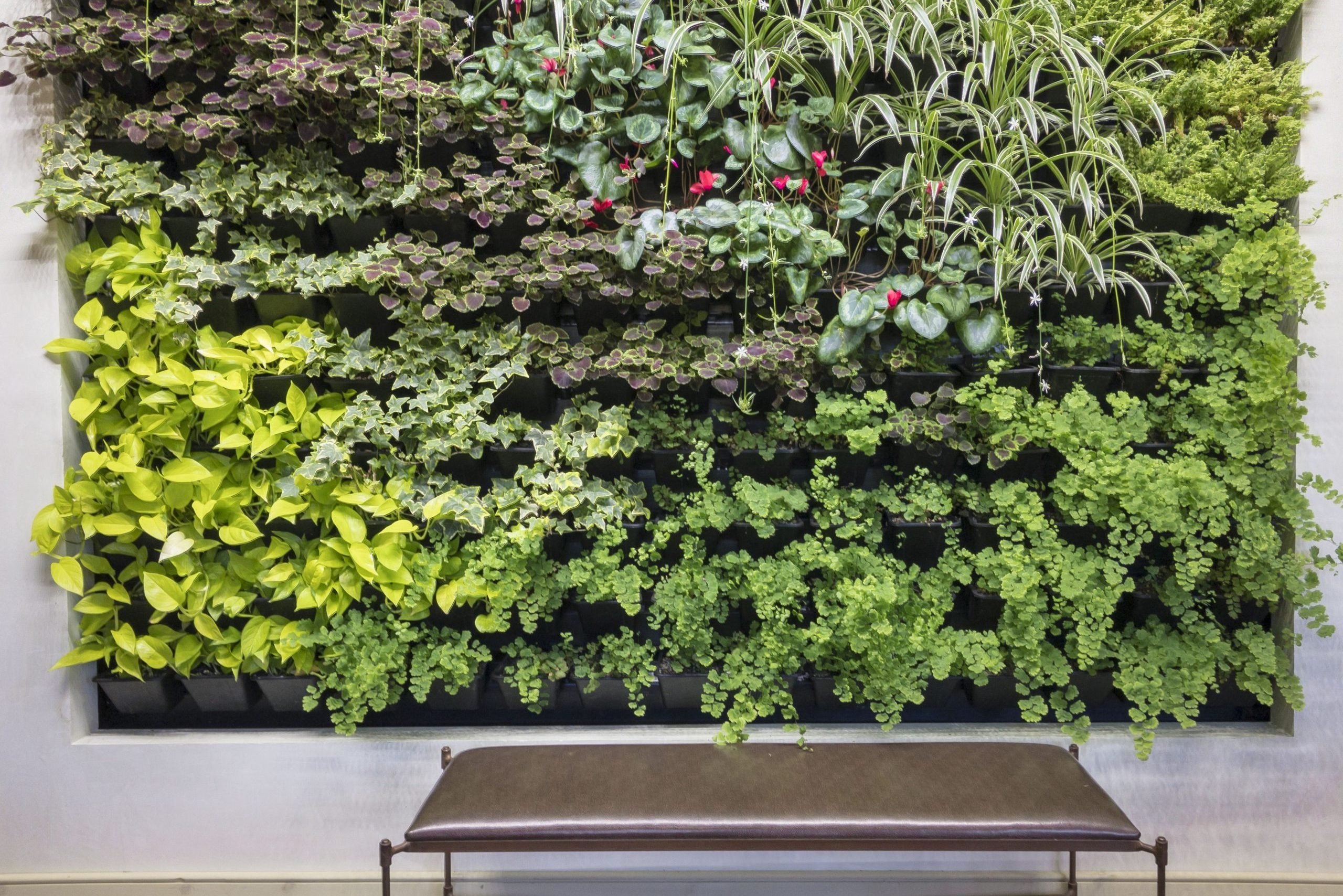
Take into account the lighting conditions and temperature of your space before selecting plants. Some plants require more sunlight, while others prefer shade. Make sure your chosen plants can adapt to the conditions of your living wall.
3. Create a diverse arrangement
Add visual interest to your living wall by mixing plants with different textures, colors, and sizes. A combination of cascading plants, tall grasses, and vibrant flowers can create a dynamic and eye-catching display.
4. Use a variety of planters
Explore different types of planters to add depth and visual appeal to your living wall. Hanging baskets, vertical planters, and pocket systems are great options to create a layered and multidimensional look.
5. Install an irrigation system
To ensure your living wall stays healthy and well-maintained, invest in an irrigation system. This will help provide the right amount of water to your plants and prevent overwatering or underwatering. You can opt for a drip irrigation system or a self-watering system.
6. Incorporate creative elements
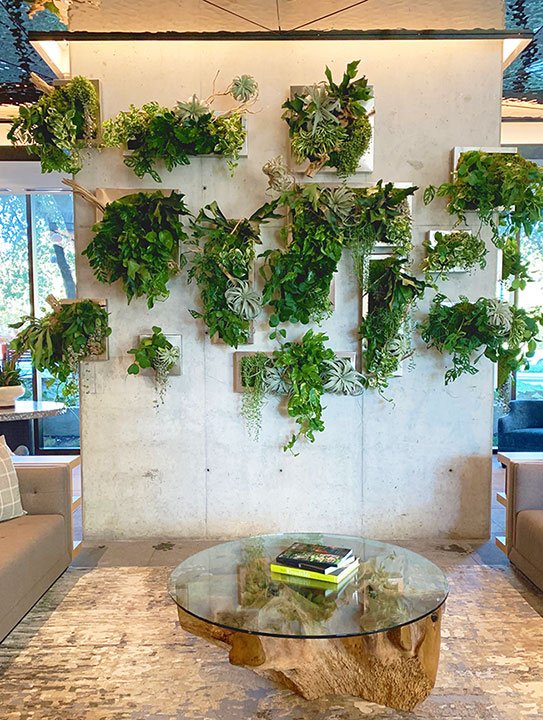
Add creativity and personality to your living wall by incorporating additional elements. This could include hanging decorations, artwork, or even small sculptures. Let your imagination run wild to truly make your living wall a unique and personalized space.
7. Regular care and maintenance
Once your living wall is set up, it’s essential to provide regular care and maintenance to keep it looking its best. This includes pruning, fertilizing, and monitoring the overall health of your plants. Stay up-to-date with any recommended care instructions or policies provided by your chosen plant supplier or biotecture system.
By following these tips, you can create a stunning and inviting living wall that will be a focal point in any space. Whether it’s a small vertical garden in your balcony or an expansive green wall in your backyard, a well-decorated living wall can transform any area into a lush and vibrant oasis.
What are the best plants for a living wall
When it comes to creating a living wall, choosing the right plants is crucial. The plants you select will determine the success and overall look of your vertical garden. Here are some of the best plants that are commonly chosen for living walls:
Heucheras
- Also known as coral bells, heucheras are a popular choice for living walls due to their vibrant foliage.
- They come in a wide range of colors, from deep burgundy to bright lime green, making them a great option for adding pops of color to your living wall.
Carex
- Carex, also known as sedge, is a versatile plant that can thrive in both sun and shade, making it suitable for different areas of your living wall.
- It has narrow, grass-like foliage that adds texture and movement to your vertical garden.
Vinca
- Vinca, or periwinkle, is a low-maintenance plant that is perfect for busy individuals who are looking for a hassle-free living wall solution.
- It has trailing vines and colorful flowers that will cascade down your green wall.
These are just a few examples of plants that work well in living walls. Depending on your location and conditions, there are many other options to consider, such as ferns, mosses, and grasses.
When choosing plants for your living wall, it’s important to consider their water and care requirements. Some plants may need more frequent watering, while others are drought-tolerant and require less maintenance.
Additionally, you should take into account the irrigation system you will be using for your living wall. There are various systems available, including drip irrigation and misting systems, which ensure that your plants receive the right amount of water.
To create a truly stunning living wall, it’s a good idea to mix and match different plants with varying textures, colors, and heights. This will add depth and visual interest to your vertical garden.
Remember to regularly check the plants for any signs of stress or disease, and prune as needed. By taking proper care of your plants, you can ensure that your living wall remains lush and healthy.
For more ideas and inspiration on living wall gardens, be sure to subscribe to our newsletter and get the latest tips and trends delivered right to your inbox.